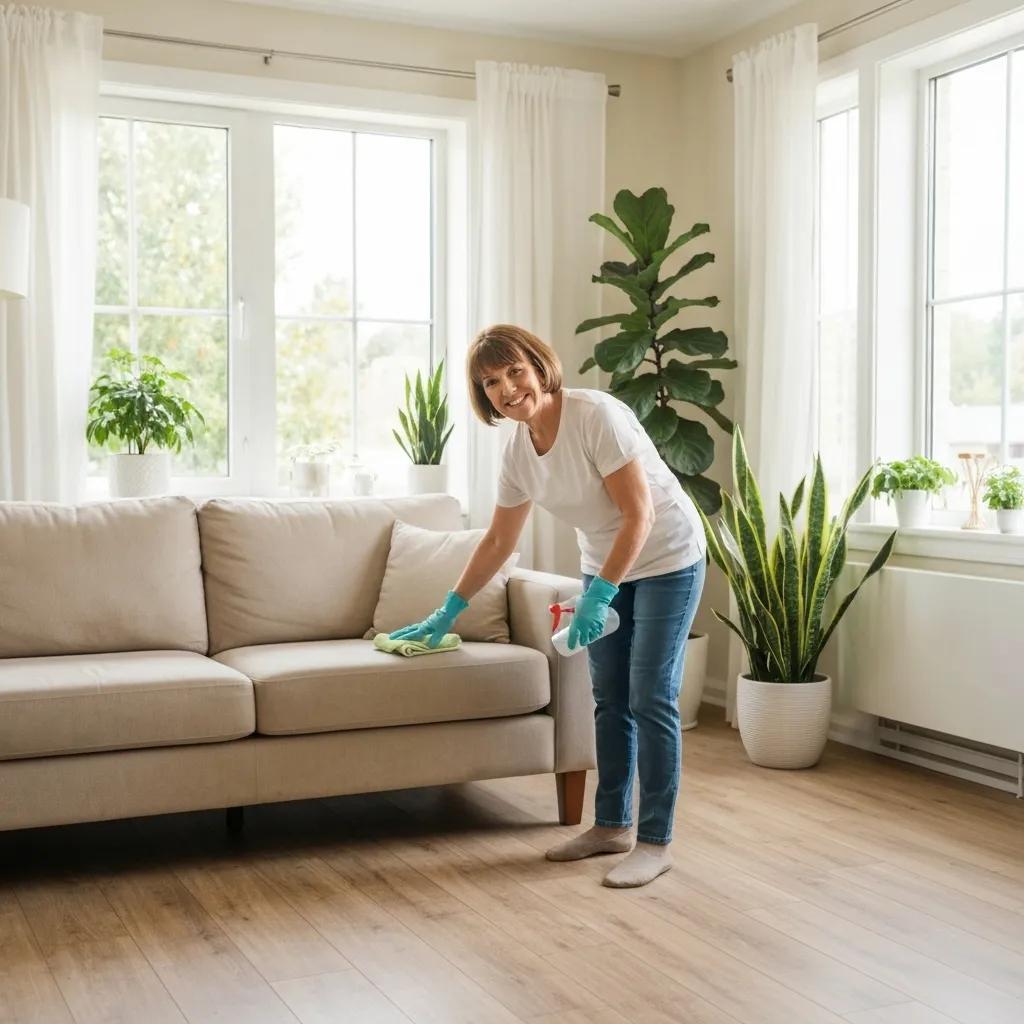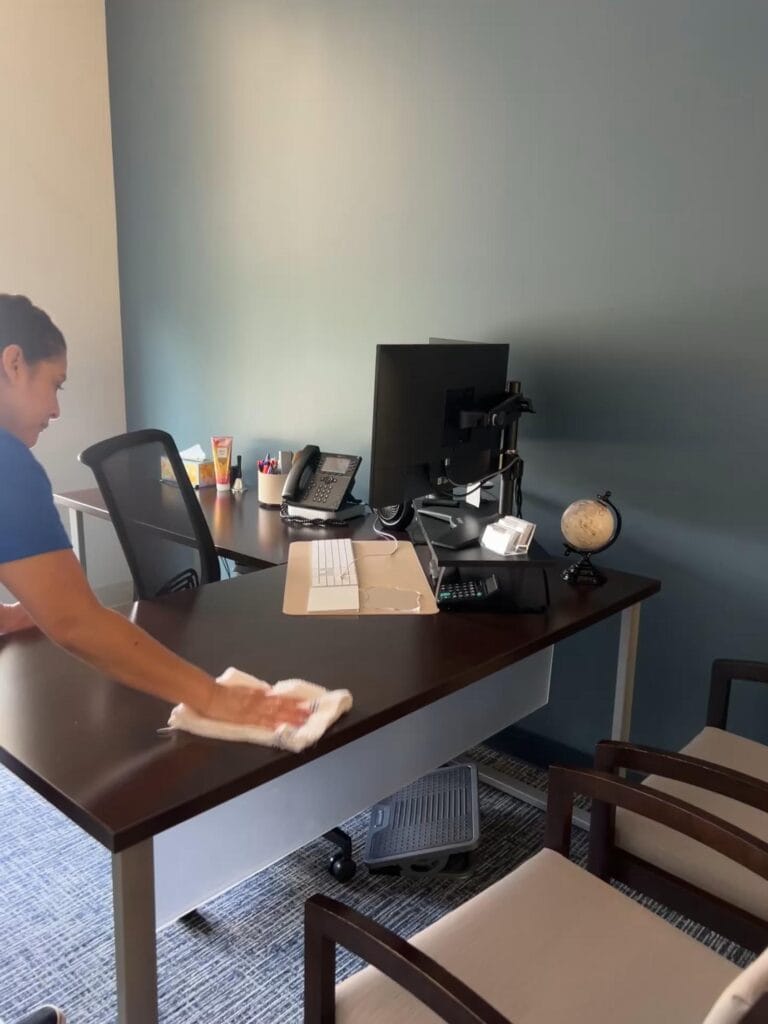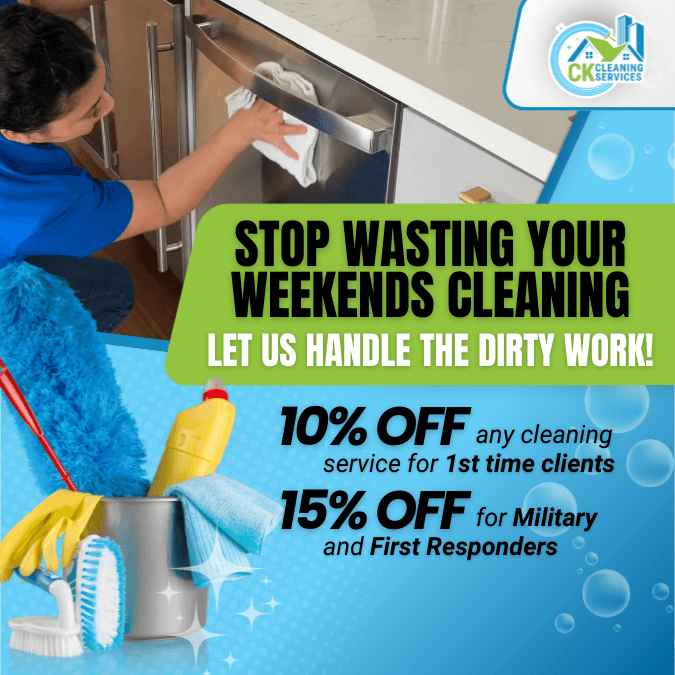For allergy sufferers, a clean home is more than just a matter of appearance—it’s a vital part of maintaining health and wellness. Everyday dust, pet dander, pollen, and mold spores can trigger uncomfortable and sometimes severe allergic reactions, turning your living space into a source of discomfort rather than a sanctuary. While regular tidying helps, truly allergen-free environments require deep cleaning techniques and specialized equipment that often go beyond typical DIY efforts. In this guide, we’ll explain why professional residential cleaning for allergy sufferers is essential, detailing how expert cleaners target and eliminate hidden allergens to create a healthier, more breathable home.
Cleaning for Allergy Sufferers: How to Breathe Easier at Home
What Are Indoor Allergens?
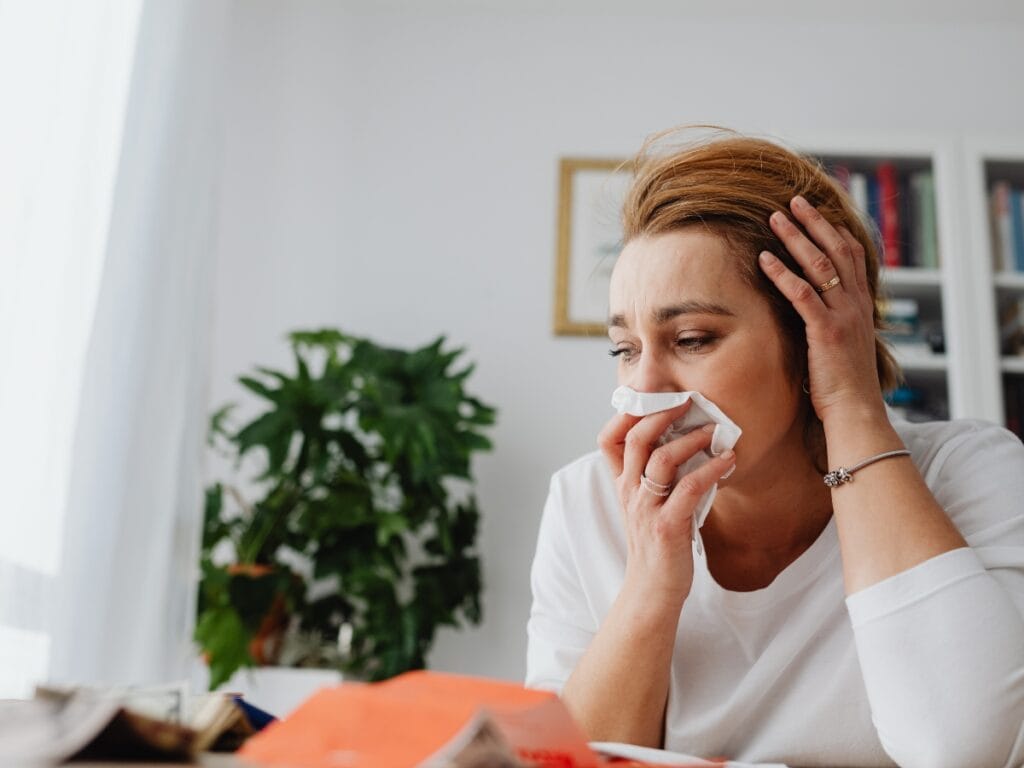
Indoor allergens are tiny particles that confuse your immune system and stir up sneezing, watery eyes, and breathing trouble. The big four are dust mites, pet dander, mold, and tracked-in pollen. Each behaves differently, but they share one trait: they hide in everyday places and build up fast without a plan to remove them.
Dust mites thrive in soft surfaces. Mattresses, pillows, carpets, and upholstered furniture collect skin flakes that mites feed on. Their droppings become airborne when you sit, vacuum without a HEPA filter, or make the bed. Encase mattresses and pillows, wash bedding hot, and use a sealed HEPA vacuum to keep levels down.
Pet dander is made of tiny skin and saliva proteins from cats and dogs. It clings to textiles and floats for hours, so it lingers long after a room looks clean. Frequent grooming outdoors, laundering throws, and running a high-efficiency air purifier reduce the load without limiting cuddle time.
Mold needs moisture and a food source. You will often find it on window sills, bathroom grout, basement walls, and in drip pans. Keep indoor humidity near 45 percent, run exhaust fans during and after showers, and fix leaks quickly. Treat small spots with proper cleaners and address the moisture that caused them.
Pollen rides in on open windows, shoes, and pets. It settles on floors, blinds, and vents. During high-pollen days, rely on HVAC with quality filtration instead of open windows, and clean entry mats often so pollen does not spread through the house.
How Indoor Allergens Affect Respiratory Health
Exposure to these particles can irritate nasal passages and lungs, leading to cough, wheeze, and sinus pressure. People with asthma or allergic rhinitis feel it most, but anyone can experience fatigue and poor sleep when air quality dips. The good news is that routine, targeted cleaning interrupts the cycle that allows allergens to accumulate and recirculate.
Where Allergens Hide And How They Hit You
Bedrooms are the top hotspot because you spend hours there. Focus on mattresses, pillows, curtains, and under-bed storage that traps dust. Living rooms collect dander and dust in sofas, rugs, and media consoles. Kitchens and baths add humidity, which invites mold on grout, under sinks, and around refrigerators. HVAC systems move everything around, so a dirty filter or dusty return vent spreads allergens room to room.
Practical Cleaning For Allergy Sufferers
Set a simple schedule and stick to it. In bedrooms, wash sheets and pillowcases weekly in hot water, and vacuum mattresses and rugs with a HEPA machine. In living areas, vacuum high-traffic zones every few days, then damp-dust hard surfaces so particles do not go back into the air. In baths, squeegee tile after showers and run the fan for at least 20 minutes to dry surfaces. In kitchens, wipe under small appliances and empty drip trays where moisture can pool.
Support those habits with the right tools. Use a sealed HEPA vacuum, microfiber cloths that grab fine particles, and MERV 11 to 13 HVAC filters changed on schedule. Place washable mats at doors, keep shoes at the entry, and brush pets outside to stop dander and pollen at the source. If carpets trigger symptoms, consider hard flooring with washable rugs.
Build A Home Routine That Sticks
Aim for quick daily tasks that keep dust from settling, a weekly deep pass for fabrics and floors, and a monthly check of vents, window tracks, and hidden moisture spots. Small, steady effort beats occasional marathon cleans. With a focused plan built around cleaning for allergy sufferers, your home’s air stays clearer, surfaces stay cleaner, and allergy flare-ups become less frequent.
How Do Dust Mites Kick Off Allergy and Asthma Symptoms?
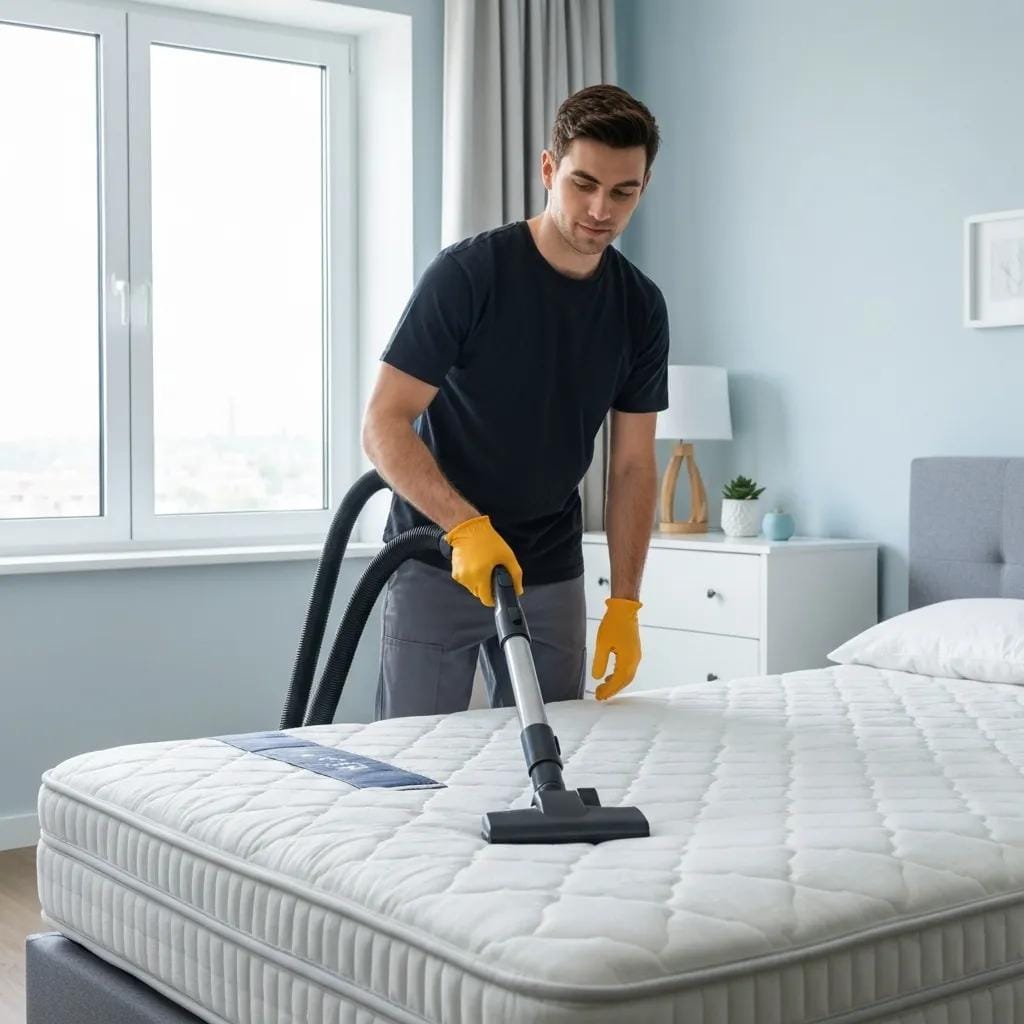
Dust mites thrive in warm, fabric-heavy spots like mattresses, pillows, and upholstered furniture. They leave behind waste that contains proteins known to set off immune reactions. When those particles become airborne and reach your airways, the body releases histamine, which can lead to sneezing, coughing, and chest tightness. Breaking this cycle starts with moisture control and frequent fabric care. Wash bedding in hot water, encase pillows and mattresses, and use a sealed HEPA vacuum on carpets and upholstery. Replace dry dusting with slightly damp microfiber so particles are trapped instead of scattered. As part of regular cleaning for allergy sufferers, these steps shrink mite habitats and lower daily exposure.
Why Is Pet Dander Such A Big Indoor Allergen?
Pet dander is made of tiny skin flakes and saliva proteins from cats and dogs. These particles cling to soft surfaces, hide in corners, and can stay suspended in the air long after playtime ends. Once inhaled, they may cause itchy eyes, rashes, and tightness in the chest. Relief comes from consistency. Vacuum rugs, sofas, and drapes with a HEPA machine, bathe and brush pets outdoors when possible, and launder throws and pet bedding often. For hard floors, a damp mop picks up fine debris better than a dry sweep. Enzyme-based cleaners can help break down residue on problem spots, making rooms more comfortable without heavy fragrances that may irritate sensitive noses.
How Do Mold And Mildew Impact Your Home’s Air Quality?
Mold and mildew flourish where humidity lingers, such as bathrooms, basements, window sills, and under sinks. They release spores and volatile compounds that irritate nasal passages and can worsen asthma. The first fix is moisture control. Run exhaust fans during and after showers, repair small leaks quickly, and use a dehumidifier if rooms feel clammy. Scrub grout and hard surfaces with a mild, non-chlorine cleaner, rinse well, and dry thoroughly. Porous items that stay damp should be discarded rather than cleaned. After problem areas are addressed, keep air moving with proper ventilation and replace HVAC filters on schedule so spores are captured instead of recirculated through the house.
What Role Does Pollen Play Indoors For Allergy Sufferers?
Pollen is an outdoor problem that easily becomes an indoor one. It rides in on clothing, shoes, and pets, then settles onto floors, blinds, and vents. Each time you sit on a sofa cushion or switch on a fan, particles can go right back into the air. Limit entry by keeping windows closed on high-pollen days and making shoes a doorway habit. Wipe hard surfaces with damp microfiber, vacuum carpets and rugs with a HEPA machine, and wash lightweight curtains regularly. At entry points, use washable mats and clean them often. Small habits like these reduce the load on your air and make every room easier to breathe in, especially during peak seasons when symptoms tend to spike.
Professional crews lower indoor allergen levels by pairing the right tools with a methodical plan. HEPA vacuums remove fine particles from carpets, rugs, and upholstery, while damp microfiber cloths trap dust on hard surfaces instead of pushing it back into the air. Targeted deep cleaning for mattresses, curtains, vents, and other fabric-heavy zones interrupts allergen build up where it starts. For anyone focused on cleaning for allergy sufferers, this whole-home approach improves air quality rather than delivering a quick surface tidy.
How Effective Is HEPA Filtration At Reducing Allergens?
HEPA filtration is the gold standard for capturing tiny irritants. Certified filters can trap 99.97% of particles down to 0.3 microns, including dust mite fragments, pet dander, mold spores, and pollen. Used in both vacuums and room air purifiers, HEPA helps clear the air you breathe and keeps allergens from resettling after a clean.
What Special Techniques Are Used For Dust Mite Removal?
Dust mites thrive in warm, humid, fabric-rich spaces. Effective control starts with hot water laundering of bedding, zippered encasements for pillows and mattresses, and careful humidity management. Steam on compatible fabrics denatures allergen proteins, and a sealed HEPA vacuum removes loosened debris from mattresses, sofas, and carpets. Keeping relative humidity near 40 to 50 percent slows mite growth between deep cleans.
How Does A Pet Dander Cleaning Plan Improve Allergy Symptoms?
Pet dander consists of microscopic skin flakes and saliva proteins that cling to soft surfaces and linger in the air. Enzyme-based spot treatments help break down these proteins on textiles. Hot water extraction on upholstery and area rugs lifts embedded residues, while routine HEPA vacuuming of floors, drapes, and vents reduces what circulates day to day. Frequent washing of throws and pet bedding further cuts airborne levels.
Why Is Deep Cleaning Crucial For Mold And Mildew Allergy Control?
Mold and mildew release spores and volatile compounds that irritate airways. Deep cleaning targets both the growth and the moisture that feeds it. In bathrooms, basements, and kitchens, use EPA-listed cleaners on nonporous surfaces, fix small leaks quickly, and keep air moving with exhaust fans. Porous items that stay damp should be discarded rather than cleaned. After remediation, HEPA filtration and timely filter changes help capture any remaining spores.
How Does HEPA Filtration Support Ongoing Results?
Post-cleaning, HEPA air purifiers maintain gains by continuously scrubbing indoor air. Position units where you spend the most time, such as bedrooms and living areas, and replace filters on the schedule recommended by the manufacturer. In forced-air homes, upgrading the HVAC filter and changing it every 1 to 3 months prevents recirculation of fine particles throughout the house.
What Are The Benefits Of Using Hypoallergenic And Eco-Friendly Cleaning Products?
Hypoallergenic, low-VOC formulas clean effectively without harsh residues or strong fragrances that can trigger symptoms. Plant-based surfactants and neutral pH solutions are gentle on finishes and safer for sensitive skin and lungs. Used with microfiber, steam, and HEPA tools, these products deliver a thorough clean while supporting healthier indoor air for allergy-prone households.
Why Allergy-Friendly House Cleaning Is Essential For Asthma And Allergy Sufferers
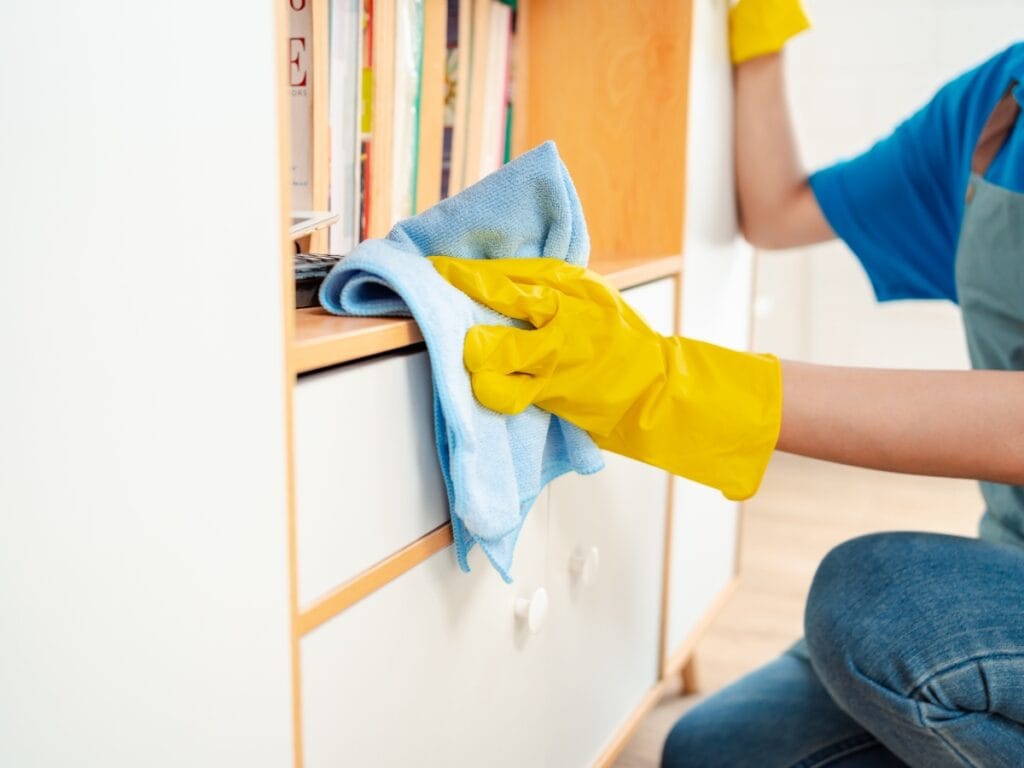
Allergy-friendly routines target the tiny particles that keep symptoms going day after day. Dust mites, pet dander, mold spores, and tracked-in pollen settle into carpets, upholstery, and bedding, then recirculate every time you sit, walk, or run the HVAC. Cleaning for allergy sufferers focuses on removing these reservoirs instead of masking odors or pushing dust around. When allergens are captured and removed at the source, indoor air becomes easier to breathe, sleep improves, and reliance on decongestants often drops. A thoughtful plan also limits moisture and organic buildup, which discourages bacterial growth and keeps rooms fresher without heavy fragrances.
How Professional Cleaning Improves Indoor Air Quality For Respiratory Health
Thorough service pairs HEPA filtration with methods that keep particles from going airborne again. HEPA vacuums pull fine debris from carpets, mattresses, and soft furnishings while damp microfiber techniques lock dust onto cloths instead of spreading it. On porous or high-risk areas, technicians may add antimicrobial or enzyme treatments that neutralize allergen proteins and address hidden sources in grout, vents, and fabric folds. This approach can cut particulate levels significantly and reduce the triggers that inflame airways. In homes with forced air, upgrading to a high-MERV filter and changing it on schedule supports the clean by preventing recirculation throughout the ductwork.
What Health Benefits Follow Consistent Allergen Control
When allergen loads drop, many people notice fewer sneezing fits, less morning congestion, and calmer skin. Nights tend to be quieter because post-nasal drip and coughing ease, which leads to deeper sleep and better focus the next day. Families with asthma often report fewer flare-ups and a lower need for quick-relief inhalers during high pollen seasons. These gains build over time because each clean interrupts the cycle of accumulation and resuspension, so the air quality improvements last longer between visits.
How Often Should Allergy Sufferers Schedule Professional Cleaning
Frequency depends on sensitivity, flooring types, pets, and seasonal factors, but a practical cadence is a deep clean every 3 to 4 months. That schedule resets fabrics, mattresses, drapes, and vents before buildup returns. Between those appointments, weekly dusting with damp microfiber and regular HEPA-vacuuming of carpets and rugs keep levels low. Bedding washed in hot water, encasements on pillows and mattresses, and indoor humidity held near 40 to 50 percent further slow dust mite growth. During heavy pollen periods, add quick wipe-downs of window sills and consider a portable HEPA purifier in bedrooms and main living areas.
Simple At-Home Habits That Support Lasting Results
Small routines make a noticeable difference. Leave shoes at the door to limit tracked-in pollen and soil. Brush and bathe pets on a schedule that fits their coat type, and launder pet bedding frequently. Fix minor leaks, run bath fans long enough to clear steam, and dry shower walls to discourage mold. If you renovate, favor hard surfaces that clean easily, choose low-pile rugs you can launder, and seal grout so it does not harbor residue. Combined with periodic professional care, these habits create a cleaner baseline that makes each session more effective and keeps your home consistently comfortable for sensitive lungs.
CK Cleaning Services GA focuses on cleaning for allergy sufferers with methods that remove, not just move, the particles that trigger symptoms. As a woman-owned, locally operated team in North Metro Atlanta, we pair careful training with eco-minded products to lower dust, pet dander, mold spores, and tracked-in pollen throughout the home. The result is a cleaner baseline that supports easier breathing, better sleep, and fewer flare-ups across the season.
How Eco-Friendly, Non-Toxic Products Aid Allergy Relief
Harsh chemicals can irritate sensitive airways, so we rely on plant-derived detergents and enzyme formulas that target allergen proteins without heavy fragrances or volatile compounds. These solutions break down residues on high-touch surfaces, fabrics, and grout while keeping indoor air clear of lingering odors. Paired with hot-water extraction and proper rinsing, this approach leaves fewer irritants behind and helps fabrics feel clean rather than coated.
Why A Detail-Oriented Cleaning Team Is Crucial For Allergen Removal
Effective allergen reduction depends on consistency and technique. Our technicians follow an allergy-aware sequence that limits resuspension: damp microfiber methods for dusting, HEPA vacuuming for carpets and upholstery, and focused attention on overlooked zones like mattress seams, vent returns, window sills, and curtain folds. By treating these reservoirs in a set order, we prevent particles from circulating between rooms and achieve longer-lasting results than a basic surface clean.
How Local Expertise In North Metro Atlanta Benefits Allergy Sufferers
Pollen waves and humidity levels vary across the northern suburbs. Our scheduling and task lists reflect what local homes face in spring and fall as well as the muggy stretch of summer. We time deep fabric care, filter changes, and moisture control steps to match those patterns. That means drier bathrooms, cleaner vents, and fewer opportunities for mold to take hold when temperatures swing.
What Customizable Cleaning Options Fit Allergy Needs
Homes differ in flooring, pets, and household routines, so plans should be flexible. CK Cleaning Services GA builds packages around your priority spaces and sensitivity level. One-time deep cleans reset mattresses, area rugs, and soft furnishings. Recurring visits maintain low allergen loads with HEPA vacuuming, damp microfiber dusting, and targeted kitchen and bath sanitation. Add-ons can focus on pet zones, dust mite control, or mold-prone areas. Frequency can scale from monthly maintenance to seasonal resets, depending on how quickly buildup returns.
The Methods That Make A Lasting Difference
Two practices raise the bar for allergy relief. First, true HEPA filtration captures fine particles down to 0.3 microns so they do not recirculate through the room or HVAC. Second, moisture management keeps indoor humidity near the comfort range and dries wet surfaces quickly, which slows dust mite growth and discourages mildew. When these are combined with washable encasements on pillows and mattresses and regular laundering of bedding, results hold between professional visits.
What To Expect From An Allergy-Focused Visit
A typical service starts with a quick walkthrough to identify hotspots, followed by sequential cleaning that moves from high surfaces to floors. Vents and returns are wiped, fabrics receive HEPA vacuuming, hard floors are damp mopped, and bathrooms are treated to limit mold-friendly residue. You end with cleaner air pathways and surfaces that stay fresher longer, supported by a simple upkeep list you can manage between visits.
By aligning gentle chemistry, careful technique, and local know-how, CK Cleaning Services GA delivers practical, repeatable improvements for households that need real relief from indoor triggers.
CK Cleaning Services GA uses a sequence designed to remove allergens rather than push them around. The process starts with HEPA vacuuming to pull fine particles from floors, rugs, and upholstery. Next comes damp microfiber dusting so particles cling to the cloth instead of floating back into the room. Hypoallergenic enzyme treatments are applied to break down allergen proteins on hard surfaces and fabrics. Technicians then focus on known hotspots such as mattresses, vent returns, and window treatments. A final air scrub with portable HEPA units polishes off the visit by capturing any remaining airborne particles. This methodical approach to cleaning for allergy sufferers supports cleaner air and longer-lasting results between visits.
How Does HEPA Vacuuming Capture Microscopic Allergens?
True HEPA filtration traps particles down to 0.3 microns inside a sealed system, which means dust mite debris, pet dander, and seasonal pollen do not blow back through the exhaust. Multi-stage filters and tight gaskets keep captured material inside the vacuum. Using slow, overlapping passes on carpets, sofa cushions, and mattresses increases pickup and reduces the load that would otherwise settle into fibers or recirculate through the home.
Why Is Microfiber Dusting Effective For Allergen Reduction?
Microfiber has split, electrostatically charged fibers that grab and hold dust instead of pushing it around. When used slightly damp, it lifts fine particles from blinds, baseboards, sills, and electronics without leaving residue. Working top to bottom keeps loosened dust from resettling on already cleaned areas. The cloths are laundered after each visit so collected material is removed from your home entirely.
Which High-Allergen Areas Receive Targeted Cleaning?
Certain places store more allergens than others. Mattresses and upholstered furniture trap dust mite fragments deep in seams and tufts, so they get HEPA vacuuming with crevice tools and fabric-safe treatments. Window treatments collect pollen and dander that drift on air currents, so they are dusted and, when fabric allows, vacuumed. Vent returns and supply grilles are wiped to remove buildup that can reenter the airstream. Paying extra attention to these areas interrupts the cycle of resuspension that keeps symptoms active.
How Are Hypoallergenic Products Applied During Cleaning?
Technicians mist enzyme-based solutions onto surfaces where proteins from dust mites, pets, or mildew tend to persist. The product is given time to work, then residues are removed with a HEPA vacuum or a light rinse, depending on the material. This targeted application helps neutralize triggers without heavy fragrances or harsh solvents. On hard floors, a pH-neutral cleaner is used with a microfiber mop to avoid film that can trap dust again.
What Does An Allergy-Focused Visit Look Like From Start To Finish?
A visit begins with a brief walkthrough to identify problem rooms and confirm priorities. The sequence then moves from higher surfaces to lower ones and from cleaner rooms to dirtier areas to prevent cross-contamination. HEPA vacuuming covers soft surfaces first, followed by microfiber dusting of furniture, shelves, and trim. Kitchens and baths receive moisture-aware care to reduce conditions that support mold. Floors are finished last to pick up what earlier steps released. Portable HEPA purifiers run while work is underway and for a short period after, improving indoor air before the team leaves. The result is a measurable reduction in common triggers and a simple upkeep plan you can follow to keep levels low until the next service.
Frequently Asked Questions About AllergyCleaning Services
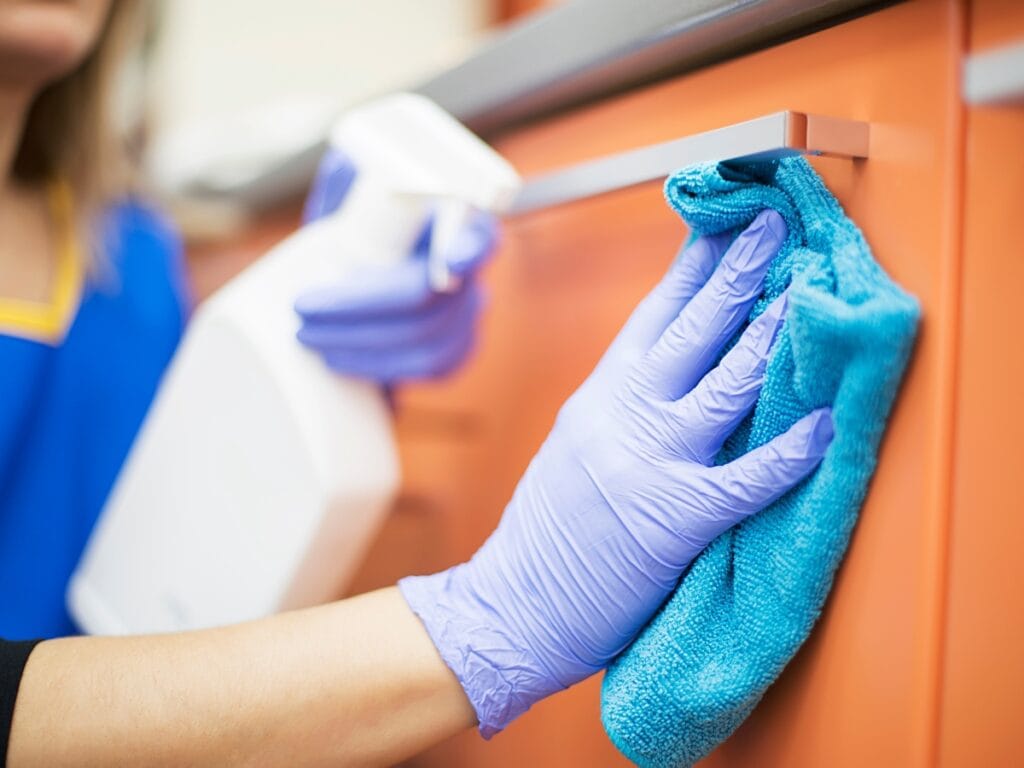
Homeowners often ask how allergy-focused cleaning differs from standard services, what health improvements to expect, and which products are most effective. Understanding these points helps you make informed choices and achieve lasting comfort.
What Is Allergy-Friendly Cleaning and How Does It Work?
Allergy-friendly cleaning targets specific triggers like dust mites, petdander, mold, and pollen using HEPA filtration, microfiber tools, and hypoallergenic formulas. This approach breaks down proteins, captures microscopic particles, and prevents them from being released back into the air.
How Does Professional Cleaning Help Manage Asthma and Allergies?
By removing up to 90% of airborne and surface allergens, professional cleaning reduces airway inflammation, decreases symptom frequency, and supports easier breathing. Regular service interrupts allergen cycles that can worsen asthma and seasonal allergies.
Are Eco-Friendly Cleaning Products Better for Allergy Sufferers?
Absolutely. Eco-friendly, non-toxic products minimize exposure to harsh chemicals and VOCs that can irritate airways and skin. Plant-based and enzyme-driven formulas effectively neutralize allergens while safeguarding your indoor environment’s health.
Can Deep Cleaning Reduce Allergy Symptoms Long-Term?
Deep cleaning eliminates allergen reservoirs in hard-to-reach places—under beds, inside vents, and within fabrics—breaking the cycle of re-infestation and providing sustained symptom relief. Regularly scheduled deep cleans help maintain low allergen levels throughout the year.
How Often Should I Schedule Cleaning to Control Allergens?
For the best allergen control, we recommend professional deep cleaning every three to four months. Supplement this with interim HEPA vacuuming and microfiber dusting appointments to maintain air quality and surface cleanliness between major services.
Ready for Allergy-Friendly Residential Cleaning in North Metro Atlanta? Here’s How!
For allergy sufferers, a clean home isn’t just about appearance—it’s about health. Dust, dander, and other allergens can trigger uncomfortable symptoms and impact daily life. At CK Cleaning Services, we specialize in deep cleaning methods designed to reduce allergens and create a healthier living environment. Our team uses HEPA filters, hypoallergenic products, and detailed techniques to target irritants at the source. Breathe easier in your home—call (678) 949-1509 or fill out our online form for your free quote today. Let us help you take control of your allergies and enjoy a fresher, cleaner space.

